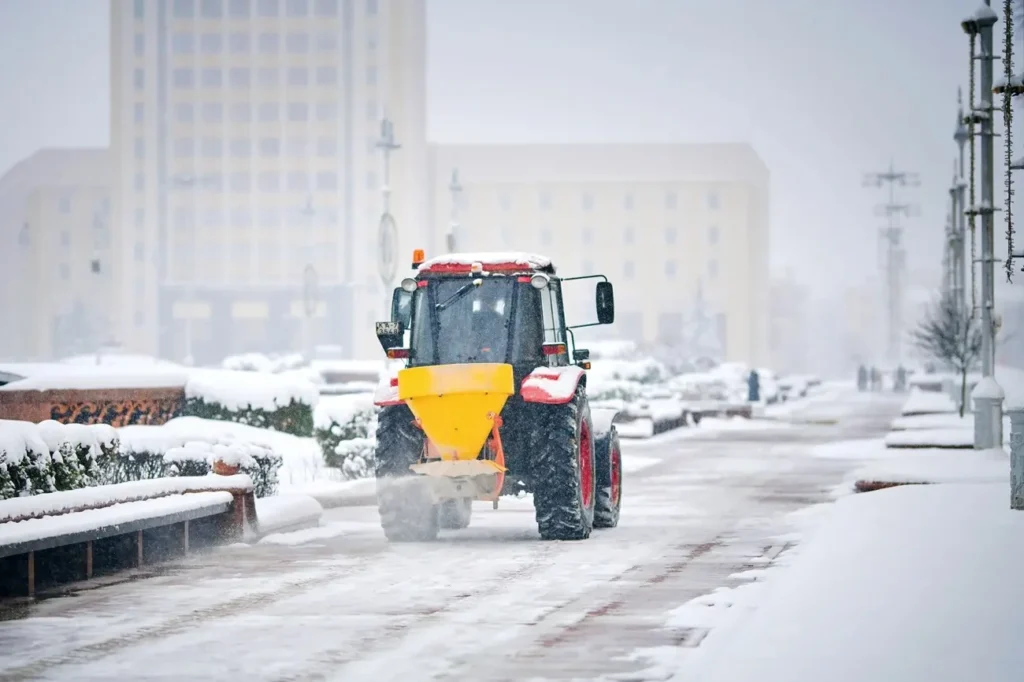Winter safety is a crucial concern in regions prone to cold weather. Effective road maintenance strategies, specifically deicing and anti-icing, play an essential role in ensuring safe travel. Deicing addresses existing ice, while anti-icing prevents ice formation. Each method has distinct applications and benefits that can greatly impact road conditions. Understanding these differences is essential for optimizing winter safety measures and decision-making in road management. What factors should be considered when selecting the appropriate approach?
Key Takeaways
- Deicing is a reactive approach used to remove existing ice, while anti-icing is proactive, preventing ice formation before storms occur.
- Anti-icing creates a barrier to inhibit ice bonding with the pavement, enhancing road safety and reducing material usage.
- Deicing methods include applying chemicals after ice formation, while anti-icing involves pre-treating roads with brine or salt before winter weather.
- Timely application is crucial; anti-icing requires accurate forecasting, whereas deicing is applied during or after severe weather events.
- Choosing between deicing and anti-icing depends on weather conditions and traffic patterns, aligning strategies with community safety objectives.
The Importance of Winter Safety in Cold Climates
As winter approaches, the significance of safety measures in cold climates becomes increasingly critical. Proper understanding of winter safety encompasses not only personal preparedness but also infrastructure maintenance. Two primary strategies employed to combat ice formation are deicing and anti-icing, each serving distinct purposes. Deicing involves applying materials to remove existing ice, while anti-icing focuses on preventing ice formation before it occurs. Recognizing the difference between deicing and anti icing is essential for effective winter management. Communities that prioritize these safety measures foster a sense of belonging among residents, enhancing mobility and reducing hazards. By implementing appropriate strategies, municipalities can guarantee safer travel conditions, ultimately contributing to the well-being of all individuals maneuvering cold climates during the winter months.
Understanding Deicing: Methods and Applications
Deicing is a critical process employed to guarantee safe travel on icy surfaces during winter months. It involves the application of chemical agents such as sodium chloride, calcium chloride, or magnesium chloride to melt ice and snow. These materials lower the freezing point of water, facilitating the removal of accumulated ice. Methods include liquid applications, where brine solutions are sprayed onto surfaces, and solid applications, where rock salt or other compounds are spread. Effective deicing requires timely intervention, especially during severe weather events, to promote road safety and accessibility. Understanding deicing is essential for communities seeking to implement effective winter maintenance strategies, highlighting the difference between deicing and anti-icing in achieving ideal winter safety.
Exploring Anti-Icing: Techniques and Benefits
While winter weather can create hazardous conditions, anti-icing serves as a proactive measure to prevent ice formation on roadways and surfaces. This technique involves applying a preemptive treatment, typically using liquid brine or solid salt, before winter storms occur. By creating a barrier, anti-icing minimizes the bonding of ice to the pavement, facilitating easier removal and enhancing safety. Key benefits include reduced material usage, lower labor costs, and improved roadway safety for motorists and pedestrians alike. Effective anti-icing strategies require accurate weather forecasting and timely application to guarantee peak results. To conclude, understanding the techniques and benefits of anti-icing is essential for maintaining safe travel conditions during winter, highlighting its importance in the broader context of winter safety efforts.
Key Differences Between Deicing and Anti-Icing
Understanding the various strategies for winter road maintenance reveals significant distinctions between anti-icing and deicing. Anti-icing is a proactive approach that involves applying chemicals to prevent ice from bonding to the pavement, thereby reducing the need for subsequent treatments. This method is typically employed before winter storms, creating a protective barrier. Conversely, deicing is a reactive strategy used after ice has formed, involving the application of chemicals to break the bond between ice and the road surface. While deicing can quickly restore safety, it may be less effective in severe conditions. The difference between deicing and anti-icing lies in their timing and purpose, with anti-icing focusing on prevention and deicing addressing existing hazards.
Choosing the Right Approach for Winter Road Maintenance
Selecting the appropriate strategy for winter road maintenance requires careful consideration of various factors, including weather conditions, traffic patterns, and the specific needs of the roadway. Deicing and anti-icing represent two distinct approaches that can greatly impact safety and efficiency. In environments where immediate ice formation is likely, deicing may be favored for its rapid effectiveness. Conversely, anti-icing is advantageous in preemptively preventing ice accumulation, particularly under forecasted adverse conditions. Decision-makers must assess road usage, potential hazards, and environmental implications to determine the best method. Ultimately, understanding the difference between deicing and anti-icing guarantees that maintenance strategies align with community safety objectives and resource management, fostering a sense of belonging and shared responsibility among all stakeholders involved in winter road maintenance.
Frequently Asked Questions
How Do Weather Conditions Affect Deicing and Anti-Icing Effectiveness?
Weather conditions greatly impact deicing and anti-icing effectiveness. Factors such as temperature, precipitation type, and wind influence the application and performance of these treatments, determining their ability to prevent or remove ice from surfaces effectively.
What Materials Are Commonly Used in Deicing and Anti-Icing Processes?
Common materials used in deicing include sodium chloride and calcium chloride, while anti-icing often utilizes magnesium chloride and potassium acetate. These substances effectively reduce ice formation, enhancing safety during winter weather conditions on roadways.
Are There Environmental Concerns Related to Deicing and Anti-Icing?
Environmental concerns related to deicing and anti-icing include potential water contamination, soil degradation, and negative impacts on vegetation and aquatic ecosystems. These practices can lead to increased salinity and chemical runoff, prompting calls for environmentally friendly alternatives.
How Often Should Deicing and Anti-Icing Be Applied During Winter?
Deicing and anti-icing should be applied as needed, typically before and during winter storms. Frequency depends on weather conditions, road temperatures, and precipitation types, ensuring ideal safety and road performance throughout the winter season.
Can Deicing and Anti-Icing Methods Be Combined for Better Results?
Yes, combining deicing and anti-icing methods can yield improved results. This synergistic approach enhances safety by preventing ice formation while effectively removing existing ice, thereby ensuring safer surfaces during winter conditions for all users.
Conclusion
In summary, effective winter road maintenance hinges on the strategic application of deicing and anti-icing techniques. While deicing serves as a reactive measure to existing ice and snow, anti-icing proactively prevents ice formation, promoting safer driving conditions. Understanding the distinct methodologies and their appropriate applications based on weather and traffic conditions is essential for optimizing resource use and enhancing overall winter safety. By implementing these strategies judiciously, municipalities can greatly improve road safety during the winter months.
You May Also Like To Read:

